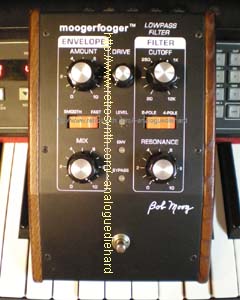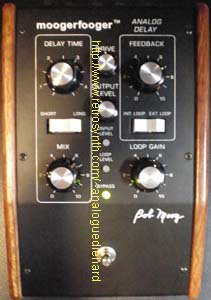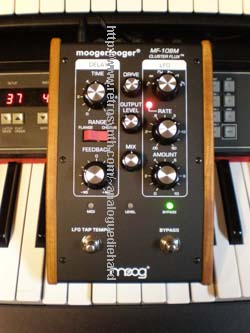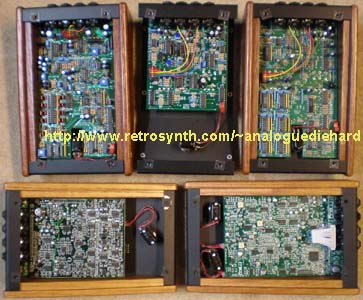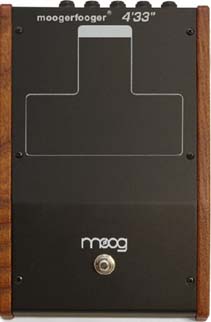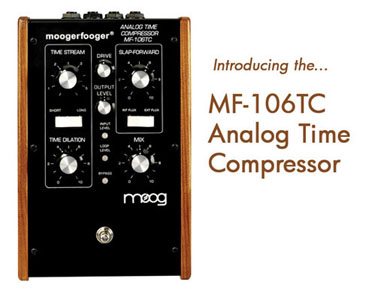Moog Moogerfooger analog effects
Update
07-07-2012
Bob Moog's first entry into the commercial market under his company Big
Briar (later Moog
Music) was the Moogerfooger line of effects
pedals. They are designed for guitars, keyboards, drum machines,
or any audio application. Many have complained about the prices
of the floor stompbox format, but these are professional low noise wide
bandwidth audio processors
with features not found on other stompbox effects.
For those curious about the origin of the name, Bob had visited a
studio and noticed one of the mixer channels was labeled
"moogerfooger". He learned that the owner had a heavy Brooklyn
accent and this label was the translated from his pronunciation of a
very unflattering metaphor.
The first of the
pedals were the MF-101 low pass filter and MF-102 ring modulator which
were released in 1998. While
they are not the first devices of their kind they were the start of the
Moogerfooger tradition of voltage control of device parameters.
Bob Moog pioneered the concept of voltage control in the synthesizer
industry and with the Moogerfooger line he extends it to effects
processors. Besides voltage control, these devices are well
featured. The later devices (with the "M" suffix) would
incorporate control of parameters over MIDI, ushering in the 21st
century.
All the Moogerfooger pedals feature an input gain
control to
provide 35dB of gain, which will accommodate anything from low-level
guitar to (+)4dBm line level
sources.
A tri-color LED shows green for signal presence, yellow for low level
overdrive, and red for distortion/clipping. Overdrive is
purposely built in and
designed to be warm sounding, while increasing the gain will generate
stronger distortion and will eventually clip the internal
circuits.
So if you are dealing with a percussive signal and want to exploit the
overdrive, it will take a little experimentation to find the gain
setting that sounds good to your ears. Otherwise your optimum
gain setting is where the LED occasionally blinks yellow. This is
a nice compact indicator of gain while keeping the
signal to noise level reasonable.
Voltage control is provided at TRS jacks
on the rear panel. They
can be used with passive attenuators such as CV (control voltage)
pedals consisting of a simple pot - the ring supplies the (+)5.7VDC
source which is current limited to 0.5mA, the tip receives the
attenuated voltage from the pot, and sleeve is ground. The full
range of the CV-able pot can be accomplished with a 0VDC to (+)5VDC
range at the CV jack. Active CV sources such as sequencers,
analog synthesizer modulation sources (such as sample-and-hold), or
MIDI-to-CV converters can be used by wiring a TRS plug with the ring
left unconnected. A TS plug can safely be used as the current
limiting with ring shorted to ground will prevent damage, but it will
also render the ring inactive (and other passive attenuators) at the
other jacks. Besides external CV modulation, these CV jacks allow
the device to be pseudo-programmable by turning all the CV-able knobs
fully counterclockwise, connecting their CV jacks to a MIDI-to-CV
converter, and using MIDI messages from your MIDI sequencer to
"program" the device in real time. Rocker switches and the
input/output level controls will not have voltage control.
A footswitch bypass the processor circuit,
with an LED indicating
active or bypass status so you can tell at a glance whether it is
active. The footswitch is rugged enough for foot operation while
easy to press with the thumb, so the Moogerfooger can be used on the
floor or on the tabletop. The bypass is buffered and not a true
bypass. Many guitar players are biased against buffered bypass
because they don't want anything to alter their tone. Many guitar
players also believe anything they hear/read and there are many myths
surrounding the guitar industry (professional artists often are the
source of these myths as they don't want copycats on their trail -
Eddie Van Halen* and Billy Gibbons are notorious for this
practice). Bob Moog has had design experience with guitar
processors - when the 1970s Moog Music was part of the Norlin
conglomerate Bob designed the Lab Series amplifiers and the
wedge-shaped Maestro stompboxes.
Bob chose the buffered bypass for an important reason - it
significantly reduces the effect of cable capacitance. The high
output impedance of guitar pickups combined with the capacitance of
cables form a lowpass filter that robs your guitar of high
frequencies. Cable capacitance is specified per foot so the
longer the cable the worse the loss of high frequencies - the loss can
occur with cable as short as ten feet. With true bypass, a chain
of stompboxes all add up to the equivalent of a very long cable and you
start losing high frequencies. But with buffered bypass, the
output impedance is now low impedance which renders the effect of cable
capacitance ineffective. Therefore guitar players have it the
wrong way around - it is true bypass that alters the tone of their
guitar, not buffered. Does the Moogerfooger buffer circuit alter
the tone? Consider the designer - Bob Moog. He has a long
history of audio circuit design with input from musicians and is no
slouch with music devices. If anybody is going to get the bypass
buffer designed right, he's your man.
Many stompboxes are powered from compact batteries and thus suffer from
design compromises that sacrifice signal-to-noise level, headroom,
frequency response, quality of the effect, and depth of features.
Because the Moogerfooger line is powered from a beefier power source in
the form of a wallwart, there is plenty of power to design quality and
features into the devices. The power source must supply 300ma at
a regulated voltage from (+)9VDC (some of the devices will tolerate up
to a maximum of (+)12VDC, some up to (+)15VDC, some no higher than
(+)9VDC. So much for convention). The tip of the power connector
is positive.
MF-101
Low Pass Filter
Now I have PLENTY of lowpass filters in my arsenal, particularly the
Moog Ladder variety. Why would I need another one?
I was recording our jazz band and the tone of the bass player had too
much upper midrange, enough to conflict with the snare drum. EQ
didn't help. I did try using the Minimoog filter with its
external audio input but the effect didn't sound right. And I
didn't want all that cabling presenting a trip hazard. Then I was
wandering my favorite haunt for used gear and they had a used MF-101
with EP-1 pedal and gigbag. It dawned on me that the 12dB/oct
slope
might be the ticket to tame that bass. Indeed it was - the
12dB/oct
(2 pole) slope sounded better than the 24dB/oct (4 pole) slope found in
most Moog synthesizers. While it gently rolled off the upper
midrange, it also firmed up the low end and resulted in a great
sounding bass tone. 12dB/oct doesn't roll off the cut band
harmonics as sharply as 24dB/oct, which is why it sounded better for a
bass guitar.
Not that there was anything wrong with the 24dB/oct slope - it is all a
matter of application.
Besides correcting bass timbres, I have a future application for this
box. I have some MIDI orchestrations in the works, and I want to
use this box to dynamically change the timbre of my static samples from
my Kurzweil
romplers. Those Kurzweils have no on-board filter and I
wanted the timbre to change with volume/breath pressure like the real
thing - this required an envelope follower. I had nothing in my
arsenal that contained an envelope follower, and that is where this box
will fill that gap.
The filter has a nice resonant color in either 2 pole or 4 pole mode,
and its cutoff AND resonance can be voltage controlled. This
feature alone is excellent for shoehorning into a synthesizer if you
have filter(s) that are weak sounding. The envelope follower
generates a control voltage that corresponds to the amplitude of the
input signal. This control voltage is applied to the filter
cutoff via the AMOUNT control, and that control voltage is available at
a rear panel jack (YAY!). It has a FAST and SMOOTH response - the
difference is how closely the envelope tracks the amplitude. FAST
is near instantaneous, while SMOOTH has added rise/fall time to the
response. The latter is best for stringed instruments with rapid
transients, while the former is best for instruments with slower
transients like strings, reeds, and brass. You can use the MIX
control to blend from 100% dry to 100% wet. Rear panel jacks
provide voltage control of mix, amount, cutoff, and resonance. A
nicely rounded out pedal.
This one is one of the early Big Briar models - the company under which
Bob operated until he regained his namesake trademark back and changed
it to Moog Music - easily identified with the facsimile "Bob Moog"
autograph on the face instead of the moog logo. From the IC
datecodes this specimen was built in 1999. But hold on, there is
an interesting component in here - a CA3080. These haven't been
made since the early 2000s, so later models would have had a component
substitution due to an obsolete part. The 3080 is an OTA that was
commonly used during the 1970-80s as VCAs and as control elements for
filters in analog synthesizers. As famously used in Moogs and
Oberheim SEM-based designs, the 3080 could be driven (and indeed was)
into nonlinearity to impart a subtle overdrive on the signal, which is
one reason that vintage synths have a high end "sheen" that is missing
from modern analog synthesizers. Since the filter resonance can
be voltage controlled, the obvious application for that 3080 was in the
feedback path of the filter which had been utilized in previous Moog
models such as Source and Memorymoog - both which exhibit that vintage
"sheen". If I find one of the later models it would be an
interesting comparision between the two.
MF-102 Ring
Modulator
The Ring Modulator is the oddball of my collection and is best at
special effects. The ring
modulator concept produces sum and difference harmonics from a carrier
oscillator (built into the unit) and a modulator
signal (your audio source).
The audio results can be quite clangorous (bell-like) and can range
between the extremes of radical and musical.
To clarify how Ring Modulation works, assume a carrier signal
consisting of a sine wave at 500hz, and the modulator signal another
sine wave at 100hz. The sum of these harmonics (500 plus 100) is
600hz and the difference (500 minus 100) is 400hz. The resulting
sum/difference set of new harmonics have little to no audible harmonic
relationship to their original signals. The original signals are
suppressed from the ring modulator output although you can blend your
audio source with the mix control. More complex harmonics can
result using non-sinusoidal waveforms, which is where your audio source
comes in. The Ring Modulator can transform waveforms of simple harmonic
structure such as square or triangle waves into complex waveforms, a
good tool for generating complex LFO waveshapes for your
synthesizer. The result resembles amplitude modulation, and in fact
guitar-style tremolo can be achieved by configuring the modulator at
very low frequencies.
If you manually sweep the modulator frequency up and down you will hear
the sum/difference harmonic sets sweeping up and down. If you
hear harmonics at one extreme reverse direction, they are going
"through zero" and the frequencies become negative. In the audio
domain negative and positive frequencies sound the same, it is the
sweep through zero frequency that is the special effect. This is
one of many special effects that this puppy can do. This "sweep"
effect can be done automatically using the LFO, whose rate is indicated
with an LED. The LFO supplies square or sine waveforms with an
adjustable rate of 0.1hz to 25hz and
adjustable modulation depth ("Amount" knob).
This box has a generous rear panel. The outputs of the LFO and
the carrier oscillators are available at separate jacks for use as
modulation sources for external devices. The LFO output swings at
+/-1.5V while the carrier at +/-1.25V. Since the carrier can be
frequency modulated with the LFO this can be an interesting modulation
source for your analog synthesizer or another Moogerfooger
device. Also included is a carrier input jack which replaces the
internal carrier source with another audio source of your choice, with
best results at (-)4dBm (or 0.5Vrms). Under this condition, keep
in mind that if either audio source is muted then so is the
output. This permits another talent of the Ring Modulator - a
frequency doubler. If you apply the same signal to both carrier
and modulator, the difference is zero while the sum is double resulting
in a pitch an octave higher (although higher harmonics may be
attenuated due to the limited bandwidth of the IC performing ring
modulation).
The CV jacks on the rear panel provide remote control of carrier
frequency, LFO rate, LFO amount, and Mix. If you have the Moog
Voyager with the VX-351 option then you can use the envelopes, LFO,
pitch bend wheel, S&H, touchpad X/Y/Z et al to go hog wild with this
box. This thing can get really sick.
The Ring Modulator and Low Pass Filter are the only Moogerfooger
processors that do not have an adjustable output.
top
MF-103
6/12-stage Phaser
This box harkens back to the days of 1970s - an OTA-based phase shifter
configurable into 6 stage or 12 stage. I would place its phasing
sound between the MXR Phase 100 and the Mutron BiPhase.
Phase shifting produces comb filter effects, so named because the
frequency response (aka spectral result) of multiple peaks and dips
resemble the teeth of a comb. In its static form, the audio
result is akin to feeling your ears being twisted from inside your
head. Actually a static phase shift is very common in certain
rooms, in the right point of reference, where the reflective ambience
can cause the same comb filter effect. A phase-shift "stage" is
the circuit element that provides (n) degrees of phase shift.
Single phase shift stage is a very subtle effect and not at all
interesting. Multiple stages configured in series can produce
thicker sounds, so a 12 stage produces the thickest sound (has more
peaks/dips in the spectral result) while the 6 stage is a pronounced
gentler effect. The Mutron BiPhase is one of the other few phase
shifters that can be configured as a 12 stage.
Much more interesting sounds result from sweeping the phase shift
automatically via the LFO. The LFO is a simple affair with only
sine waveform with rate and amount control, although you can replace it
with another LFO of your choice (or any synthesizer modulation source
such as touchpad or sequential controller) with the SWEEP IN jack on
the rear panel. The LFO can sweep from a barely discernable one
cycle every 100 seconds (0.01hz) to way in the audio range (250hz) -
the widest range in the Moogerfooger line? The LFO sweeps the
peaks/dips across the
frequency axis while maintaining the displacement between
peaks/dips. The rate of the LFO has a wide range from very slow
(for barely perceptable phase shifting) to very fast (appraoching ring
modulator effects). AMOUNT varies the depth of modulation from
the LFO and is often omitted on most stompbox phase shifters.
Rate and amount can be voltage controlled from the rear panel jacks,
and the LFO output is also available at the rear panel.
The SWEEP control sets the initial frequency centers of the peaks/dips,
while the RESONANCE control varies the depth of the dips (I may
trademark that phrase!) and the sharpness of the peaks. Both of
these can be voltage controlled via the rear panel jacks.
The AUX OUT provides a stereo effect - the spectral result is the
peaks/dips are reversed as that of the AUDIO OUT and the extreme low
and high spectra are heavily attenuated. This is not an out of
phase output which is a common stereo "cheat" among less expensive
processors. Out of phase stereo signals will cancel when summed
to mono, but the MF-103 does not suffer from this.
top
MF-104 Analog
Delay
This is the original 800ms MF-104 analog delay last made in 2001 (not
the later
1000ms MF-104Z or 1400ms MF-104SD). There were 1000 of these
units produced and they are the most sought after of the moogerfooger
pedals on the used market. The limited production was due to the
limited supply of BBD ICs, which at the time were being obsoleted by
the
manufacturer.
Two delay ranges of 400ms and 800ms are offered, the longer delay at
the expense of decreased high frequencies. This is a typical
tradeoff of analog delays because longer delay times require slowing
the delay clock driver into the audio domain, thus clock feedthrough
must be filtered out before it reaches the audio output. This is
not always a bad thing as it can emulate natural echoes which are not
full fidelity in nature. Moog doesn't provide a specification of
frequency response, but the shorter 400ms range seems to top out at
12Khz and 800ms at 6Khz.
Nothing earth-shattering about the analog delay controls - delay time,
feedback, and mix all which are voltage controllable. At feedback
above "8" it will feedback on itself, which can be a cool effect that
can be varied in real time by manipulating the feedback and/or delay
time controls. However they did neglect to include negative
feedback. The interesting feature is you can insert the processor
of your choice in the feedback loop. The manual suggests the
MF-102 Ring Modulator but that sounds really radical (I may try it with
S&H modulating the carrier). High pass filters work well for
rolling off the low frequencies, which what echo in nature sounds
like. Loop Gain compensates for passive filters such as tank RLC
circuits. I have also found the MIDIMurf useful in the feedback
loop, especially when using the pattern sequencer.
The rear panel provides both mix and delay outputs, the latter a handy
feature. If you set the mix 100% dry, you can route the delay
only signal to a separate mixer buss or to a stereo amplifier
setup. The Moog crew had some good input from musicians to have
included this.
I own two of these - these things sounded so good that I acquired a
second one back when they were still available. In hindsight it
was a wise decision as the yet-to-be-produced Moog Voyager was to have
dual filter stereo outputs, and these two analog delays sound awesome
on the Voyager stereo outputs. In fact the earlier unit used the
MN3005 BBD device, while the later one the MN3008. I haven't
closely examined the PC boards for any difference, but the part number
etched on the boards do have differing revision letters.
My only beef is that the MF-104 doesn't produce shorter delays than
40ms so you can't do Haas processing, chorus, or flange effects (that
would later come in the MF-108M).
I have never heard the MF-104Z or MF-104SD so I do not know if there
are any
sound differences. The easiest way to tell them apart is the
MF-104 has Bob Moog's facsimile signature on the front panel, while the
others have the moog logo.
top
MF-105M
MIDIMuRF
The MIDIMuRF is a MIDI controlled filter bank, effectively a
merging of the non-MIDI MF-105 and MF-105B. There is a lot of
power under this simple box.
There are eight resonant bandpass filters whose outputs can be
attenuated via
the slidepots, and a switch toggles the center frequencies of each
filter between those optimized for bass or guitar. While it looks
like a graphic equalizer, there are important differences. The
filters in the MuRF are purposely designed to be resonant so they color
the sound, the slidepots vary from unity gain to zero output, and the
filters are tuned so that adjacent bands do not overlap. The
graphic equalizer is designed with minimum color, the filters of each
band are not resonant, and the slidepots will not completely mute the
band. The graphic equalizer is designed as a correction device
with boost and cut control to minimize color, while the MuRF is
designed to intentionally color the sound but with only cut control.
Included in the MuRF is a cyclic pattern generator (labeled ANIMATION
on the front panel) which can be controlled and configured over
MIDI. The pattern generator is an eight channel 64 step sequencer
with each channel enabling or muting the independent filters, and each
channel
has its own independent envelope (triggered by the sequencer) which
shapes the volume of each filter. The MuRF is delivered with a
factory set of 24 preset patterns (12 for guitar range, 12 for bass
range) but using the MIDIMuRF Controller software
you can create and download your own patterns over MIDI.
The RATE control varies the speed of the pattern generator while the
PATTERN rotary switch selects the pattern presets. The
ENVELOPE control has a multiple function. The envelope is
technically a lag processor with adjustable rise (attack)
and fall (release) rates. The RATE control works in conjunction
with the ENVELOPE control - the ENVELOPE control defines the rise and
fall scale, while the RATE
control defines the rise and fall constant.
The actual envelope rise and fall time
is the product of scale and constant. As the ENVELOPE
control is rotated from 0 to 5, the fall factor increases more than the
rise factor. At the "5" setting both rise and fall factors are
equal. As the ENVELOPE control is rotated from 10 to 5, the rise
factor increases more than the fall factor. So the ENVELOPE
control varies both the rise and fall factors, with enough variation to
arrive at the desired effect. This is a very clever way to reduce
a panel full of knobs to just two controls (and keep costs down).
The LFO clock for the pattern generator can be controlled by the RATE
control, by MIDI clock, or by tap tempo using a footswitch (or a clock)
to the rear
panel TAP/STEP jack. The LFO rate LED changes color to tell you
whether the clock is controlled by the knob (red) or by MIDI/Tap
footswitch (green). The TAP/STEP is a TRS jack and when you plug
a footswitch in halfway, the footswitch will manually STEP through each
pattern step - a convenient tool to audition steps in a user custom
pattern.
What does a pattern generator sound like?!? Hard to describe, but
it can sound like nothing else out there.
MIX, RATE, and ENVELOPE jacks on the rear panel provide TRS voltage
control of these parameters. An LFO/SWEEP jack is dual purpose -
with the pattern generator on, an external LFO or clock can be used to
sync the pattern generator to external devices; with pattern generator
off, a CV sweeps the center frequencies of the filters. Stereo
audio outputs spread the even numbered filters to one side and the odd
numbered filters to the other side.
The MIDI implementation for this device is quite extensive. There
is too much to list here, suffice to say that just about any
conceiveable MIDI control is implemented, including MIDI control of
drive and output (!) and sysex. Every control on the front panel
can be controlled over MIDI - including the filter gain
slidepots. There are also some features
inside that are accessable only by MIDI.
I like the MIDIMuRF as a fixed filter bank on the MIX IN/OUT jack of
the Moog Voyager.
The MIX IN/OUT is used as an insert between the oscillator mixer output
and the filters. With the MIDIMuRF patched into this jack, it is useful
for varying the timbre of the oscillator(s) before they are filtered,
which gets a bigger palette of sounds. And because the MIDIMuRF
has MIDI control, your sequencer can configure the filters for each
Voyager patch. Now that's power!
What does MuRF stand for? Multiple Resonant Filter. Too bad they
didn't call it the Spectral
Multiple Resonant Filter - SMuRF (I jest :-)
top
MF-108M
Cluster Flux
Moog's latest Moogerfooger offering is the limited edition Cluster Flux
which is a wonderful sounding MIDI controlled BBD-based flanger and
chorus device. Only
1000 of these units will be made due to the limited supply of BBD
devices.
My previous beef involving the MF-104 is now
resolved with this device
- Yay!
I've seen plenty of flange/chorus processors but this box has features
I have not seen anywhere else. The usual TIME, LFO RATE, and LFO
AMOUNT are there. Not often seen is positive AND negative
feedback (with facility for self-oscillation). A very unique
feature is the variety of LFO waveshapes - it offers sine, triangle,
square,
falling ramp, rising ramp, and... sample & hold?!? This is
the only flanger/chorus I've ever seen that offered sine or triangle
modulation waveshapes, each of them resulting in a different effect -
THANK YOU! A rocker switch toggles the time delay RANGE between
FLANGE (0.6ms to 10ms) and CHORUS (5ms to 50ms). The LFO
frequency range is 0.05hz (one cycle every 20 seconds) to 50hz, wide
enough for most flange/chorus effects.
Like the MF-103 Phaser, this device generates a
comb filter
effect in FLANGE mode. A major difference is the displacement of
the frequencies of
peaks/dips is different in a time delay processor as opposed to a phase
shift processor. FEEDBACK increases the sharpness and intensity
of the peaks in FLANGE mode. Positive feedback emphasizes all the
harmonics of a fundamental frequency equal to the inverse of the delay
time (even harmonics), while negative feedback generates a completely
different comb
filter effect in which odd harmonics are emphasized and the frequency
response is shifted down one octave. If you don't comprehend that
technical explanation, just trust that positive and negative feedback
yields radically different effects. In CHORUS mode FEEDBACK
creates a detuned doubling effect, haas effect, or vibrato. You
can get a wide variety of chorus effects with variations of LFO rate,
amount, delay time, and feedback. Nice.
A new addition to the Moogerfooger format is the TAP TEMPO
footswitch. Interesting feature but with two problems: 1) how do
you tap the footswitch fast enough for 10ms flange range and 2) Moog
finally designed such a flexible LFO from so many requests, but
neglected to include an LFO OUT on the rear panel (sigh).
MIX, LFO RATE, LFO AMT, TIME, and FEEDBACK jacks on the rear panel
provide TRS voltage
control of these parameters. There is a FB INSERT jack for
inserting a processor (such as a high pass filter) in the feedback path
(tip=SEND, ring=RETURN). Stereo
audio outputs are provided, but they are simply out-of-phase outputs
which will cancel when summed to mono. An internal DIP switch
configures the outputs in variations of dry/wet/mix and phase positions
- factory default is right output & mix enabled, wet signal
out-of-phase.
The MIDI implementation for this device is quite extensive. The
BBD clock is implemented in firmware which permits a lot of control
possibilities over MIDI. Every control on the front panel (except
DRIVE) can be controlled over MIDI - you can save your flange/chorus
settings in a MIDI string in your MIDI sequencer! There are also
some features
inside that are accessable only by MIDI, such as delay time multiplier
up to x8 and delay time portamento.
This device is really effective on my Fender Rhodes Silvertop piano
and
on guitar, especially through my Selmer Zodiac
Twin Thirty amp.
The flanging can get pretty extreme and there are all kinds of chorus
variations to be had. Hard to get a bad sound from this
thing. It's a very flexible processor although a bit noisy - did
they include
a compander in this thing? And be careful with LFO waveshapes
that have stepped instantaneous edges (square, ramps, S&H) as the
control
feedthrough is a little leaky (translated: you'll hear a THUMP in the
audio). You can reduce this defect if you roll off enough bass in
your mixer channel. I think a smoothed S&H would had been
more effective than stepped.
top
Gutz
Click on the image below to see the innards of these devices.
Note the transition from through-hole components to modern SMT.
The Cluster Flux is really packed dense!
top
CP-251 Control
Processor
The CP-251 is a utility box
designed for processing and
generating control voltages. There are no audio processors in
this device. A commonly asked question is if a customer should
get a CP-251 - it is a handy accessory for the Voyager, Phatty, and
Taurus
product line; but for Moogerfooger pedals it is useful to only those
who are interested
in experimenting with processing control voltages, have two or more
Moogerfooger devices, and can grasp analog synthesizer concepts.
This toolbox includes a four input mixer with offset controls, lag
processor with independent rise/fall times, white noise soure, two
attenuators, LFO with triangle/square/S&H outputs, and a four-way
multiple. There are more features under this deceptively simple
looking panel.
There are jacks with red nuts (later units replaced them with black
nuts with a white ring label on the panel) that identify those that can
accommodate a TRS passive or active control
voltage pedal or external
control source. They are placed at strategic points.
The mixer is designed for control voltage IE it can process DC
voltages. Provided are two attenuation controls (inputs 3 and 4
are
fixed with no attenuation), an offset control, and a master
control. OFFSET adds a DC offset to the final mix, useful for
converting bipolar +/-(n)VAC signals (such as LFOs) to
Moogerfooger-compatible 0-5VDC levels. Input #3 bears a red nut
which means it can accept a TRS passive control voltage pedal.
Complimentary +/- outputs provide a 180 degree out of phase signal on
the (-) output.
The mixer CAN process audio up to 50Khz, but you must use caution so
that DC offsets are not present on the output - with the wrong
combination of equipment DC offset can cause damage. Use at your
own risk!
The LFO has a jack that can accept a TRS passive control pedal to
remotely control the rate of the LFO, which has an LED to indicate the
rate of 0.03hz (one cycle every 33 seconds) to 100hz. The S&H
works by "sampling" the noise source at the
rate of the LFO, and "holds" the sampled voltage during that clock
cycle. The OUT1 jack is the stepped S&H while the OUT2 jack
is the smoothed S&H. The S&H has a couple of normalled
jacks - input is normalled to noise source while trigger is normalled
to LFO square. The jacks allows you to use another independent
clock source for the trigger, and another source for the input (such as
pink or red noise) - and they both can accept a TRS control voltage
pedal. Quite flexible. Since the smoothing operation of
OUT2 is dependent on the LFO rate, you can use the rate control to vary
the amount of "smoothing".
What use is this "lag processor"? You use it to turn a square
wave into a trapezoid even a triangle wave, or use it to "smooth" the
stepped S&H. Some classic keyboard vibratos - such as the EMS
"Putney" or Vox Continental - use a trapezoidal waveform.
Trapezoidal also makes interesting tremolo effects like those of guitar
amps and the classic Rhodes piano stereo tremolo. Trapezoidal can
be used as a repetitive AR envelope. The lag processor also
functions as a glide processor for keyboard or sequencer pitch
CVs. Route the white noise through the lag processor to convert
it to pink, red, or blue noise.
The first jack of the four-way multiple can accept a TRS passive
control voltage pedal, which allows you to use one pedal to
simultaneously control three devices. The attenuator inputs also
accept TRS pedals which allows you to reduce the sweep range of the
pedal - handy if you're using a pedal to sweep the pitch of an
oscillator.
I got one of the early CP-251s that used red nuts. I liked the
convention of using red nuts (it looks cool) but I can certainly
understand the cost effective reasons behind using nuts of the same
color.
top
VX-351 Voyager
Output Breakout Box
The Voyager's rear panel has a comprehensive set of CV inputs,
and the VX-351 is an option to bring the
CV outputs to a breakout box. A DB25 cable is used to connect the
two together (the Voyager requires a conditioning accessory that needs
to be installed inside the chassis, which is included with the
VX-351). Pretty much all the Voyager control sources - keyboard
pitch/velocity/pressure/trigger, pitch bend wheel, mod wheel, LFO
square and triangle, S&H stepped and smoothed, envelopes, noise
source, touchpad x/y/z/gate, MOD pedals, wheel and pedal busses - are
brought out to the panel for use with Moogerfooger devices or with
external synthesizers or other audio processors with voltage control
capability. Also included are two attenuators and two sets of
four-way multiples.
top
Rackmount accessories
Because of the professional audio quality of the Moogerfooger
devices, I got the rackmount accessories so they could be racked with
my other studio processors. If I ever need to separate a device
for floorpedal use, they are easy to remove. There is also a
rackmount accessory for the CP-251 and VX-351, with the advantage that
when the VX-351 is connected to the Voyager, the CP-251 gets its power
from the VX-351 so this eliminates a wall wart power supply.
Comedy
Seems that the elves at Moog Music have a field day as April
Fool's Day approaches. Some notable examples of past April Fool's
pranks are the MF-433, the MF-106TC, and the rare coveted MF/FM.
In a sly reference to
John Cage's infamous 4'33'' composition, the MF-433 effectively
silences the audio output for 4 minutes 33 seconds at the press of the
footswitch. The MF-106TC Time Compressor has the opposite
function of analog delays in that is compresses the time of the input
audio, allowing the performer to hear notes they haven't yet
played. The MF/FM lets you bring FM radio, complete with vintage
analog tuner, to your fingertips for mangling radio audio.
top

Home
* I hold animosity towards Eddie Van Halen because he falsely claimed
that his
sound was a result of using a variac on his guitar amplifer. This
is both untrue and dangerous because the variac will cause damage to
the amplifier - even fire - to the copycat who doesn't know any
better. It is one thing to steer copycats off your trail, yet
quite another to cause a fire with the potential of property loss or
even death. That is extremely irresponsible of Eddie to spread
such a dangerous lie and I have lost all respect for him, regardless of
his place in music history.


